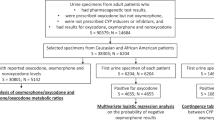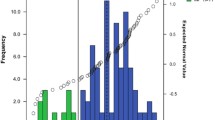Abstract
Objectives
(S)-Mephenytoin is selectively metabolised to (S)-4′-hydroxymephenytoin by CYP2C19. The urinary excretion of 4′-hydroxymephenytoin reflects the activity of individual enzymes. We evaluated fractioned urinary collection and β-glucuronidase pre-treatment in order to determine the optimal CYP2C19 metrics. We also assessed whether urinary excretion of N-desmethylmephenytoin (nirvanol) might be a useful CYP2B6 metric in in vivo studies.
Methods
A 50-mg dose of mephenytoin was administered to 52 volunteers as a component of phenotyping cocktails in four separate studies. Urine was collected up to 166 h post-dose. Urinary excretion of 4′-hydroxymephenytoin and nirvanol was quantified by liquid chromatography–tandem mass spectrometry, and common CYP2C19 and CYP2B6 genotypes were determined.
Results
Cumulative excretion of 4′-hydroxymephenytoin in urine with β-glucuronidase treatment collected from before mephenytoin administration up to 12–16 h thereafter showed the greatest difference between CYP2C19 genotypes and the lowest intra-individual variability (7%). Renal elimination of nirvanol was highest for a *4/*4 individual and lowest for individuals carrying the *5/*5 and *1/*7 genotype, but lasted for several weeks, thus making its use in cross-over studies difficult.
Conclusion
Cumulative urinary excretion of 4′-hydroxymephenytoin 0–12 h post-administration is a sensitive and reproducible metric of CYP2C19 activity, enabling the effect of a drug on CYP2C19 to be assessed in a small sample size of n = 6 volunteers. While nirvanol excretion may reflect CYP2B6 activity in vivo, it is not useful for CYP2B6 phenotyping.





Similar content being viewed by others
References
Andersson T, Miners JO, Veronese ME, Tassaneeyakul W, Meyer UA, Birkett DJ (1993) Identification of human liver cytochrome P450 isoforms mediating omeprazole metabolism. Br J Clin Pharmacol 36(6):521–530
Yasumori T, Nagata K, Yang SK, Chen LS, Murayama N et al (1993) Cytochrome P450 mediated metabolism of diazepam in human and rat: involvement of human CYP2C in N-demethylation in the substrate concentration-dependent manner. Pharmacogenetics 3(6):291–301
www.imm.ki.se/CYPalleles/cyp2c19.htm, Home Page of the Human Cytochrome P450 (CYP) Allele Nomenclature Committee. Accessed November 2007
de Morais SM, Wilkinson GR, Blaisdell J, Nakamura K, Meyer UA, Goldstein JA (1994) The major genetic defect responsible for the polymorphism of S-mephenytoin metabolism in humans. J Biol Chem 269(22):15419–15422
de Morais SM, Wilkinson GR, Blaisdell J, Meyer UA, Nakamura K, Goldstein JA (1994) Identification of a new genetic defect responsible for the polymorphism of (S)-mephenytoin metabolism in Japanese. Mol Pharmacol 46(4):594–598
Desta Z, Zhao X, Shin JG, Flockhart DA (2002) Clinical significance of the cytochrome P450 2C19 genetic polymorphism. Clin Pharmacokinet 41(12):913–958
Kirchheiner J, Fuhr U, Brockmoller J (2005) Pharmacogenetics-based therapeutic recommendations-ready for clinical practice? Nat Rev Drug Discov 4(8):639–647
Bebia Z, Buch SC, Wilson JW, Frye RF, Romkes M et al (2004) Bioequivalence revisited: influence of age and sex on CYP enzymes. Clin Pharmacol Ther 76(6):618–627
Frye RF, Schneider VM, Frye CS, Feldman AM (2002) Plasma levels of TNF-alpha and IL-6 are inversely related to cytochrome P450-dependent drug metabolism in patients with congestive heart failure. J Card Fail 8(5):315–319
Streetman DS, Bertino JS Jr, Nafziger AN (2000) Phenotyping of drug-metabolizing enzymes in adults: a review of in-vivo cytochrome P450 phenotyping probes. Pharmacogenetics 10(3):187–216
Tomalik-Scharte D, Jetter A, Kinzig-Schippers M, Skott A, Sorgel F, Klaassen T, Kasel D, Harlfinger S, Doroshyenko O, Frank D, Kirchheiner J, Brater M, Richter K, Gramatte T, Fuhr U (2005) Effect of propiverine on cytochrome P450 enzymes: a cocktail interaction study in healthy volunteers. Drug Metab Dispos 33(12):1859–1866
Harbrecht BG, Frye RF, Zenati MS, Branch RA, Peitzman AB (2005) Cytochrome P-450 activity is differentially altered in severely injured patients. Crit Care Med 33(3):541–546
Christensen M, Andersson K, Dalén P, Mirghani RA, Muirhead GJ et al (2003) The Karolinska cocktail for phenotyping of five human cytochrome P450 enzymes. Clin Pharmacol Ther 73(6):517–528
Streetman DS, Bleakley JF, Kim JS, Nafziger AN, Leeder S et al (2000) Combined phenotypic assessment of CYP1A2, CYP2C19, CYP2D6, CYP3A, N-acetyltransferase-2, and xanthine oxidase with the “Cooperstown cocktail”. Clin Pharmacol Ther 68(4):375–383
Zhou H, Tong Z, McLeod JF (2004) “Cocktail” approaches and strategies in drug development: valuable tool or flawed science? J Clin Pharmacol 44(2):120–134
Wedlund PJ, Aslanian WS, Jacqz E, McAllister CB, Branch RA, Wilkinson GR (1985) Phenotypic differences in mephenytoin pharmacokinetics in normal subjects. J Pharmacol Exp Ther 234(3):662–669
Goldstein JA, Faletto MB, Romkes-Sparks M, Sullivan T, Kitareewan S et al (1994) Evidence that CYP2C19 is the major (S)-mephenytoin 4′-hydroxylase in humans. Biochemistry 33(7):1743–1752
Heyn H, White RB, Stevens JC (1996) Catalytic role of cytochrome P4502B6 in the N-demethylation of S-mephenytoin. Drug Metab Dispos 24(9):948–954
Ekins S, VandenBranden M, Ring BJ, Wrighton SA (1997) Examination of purported probes of human CYP2B6. Pharmacogenetics 7(3):165–179
Ko JW, Desta Z, Flockhart DA (1998) Human N-demethylation of (S)-mephenytoin by cytochrome P450s 2C9 and 2B6. Drug Metab Dispos 26(8):775–778
Wedlund PJ, Aslanian WS, McAllister CB, Wilkinson GR, Branch RA (1984) Mephenytoin hydroxylation deficiency in Caucasians: frequency of a new oxidative drug metabolism polymorphism. Clin Pharmacol Ther 36(6):773–780
Kupfer A, Preisig R (1984) Pharmacogenetics of mephenytoin: a new drug hydroxylation polymorphism in man. Eur J Clin Pharmacol 26(6):753–759
Zhang Y, Blouin RA, McNamara PJ, Steinmetz J, Wedlund PJ (1991) Limitation to the use of the urinary S-/R-mephenytoin ratio in pharmacogenetic studies. Br J Clin Pharmacol 31(3):350–352
Tamminga WJ, Wemer J, Oosterhuis B et al (2001) Mephenytoin as a probe for CYP2C19 phenotyping:effect of sample storage, intra-individual reproducibility and occurrence of adverse events. Br J Clin Pharmacol 51(5):471–474
Faucette SR, Hawke RL, Lecluyse EL et al (2000) Validation of bupropion hydroxylation as a selective marker of human cytochrome P450 2B6 catalytic activity. Drug Metab Dispos 28(10):1222–1230
Chang TK, Weber GF, Crespi CL, Waxman DJ (1993) Differential activation of cyclophosphamide and ifosphamide by cytochromes P-450 2B and 3A in human liver microsomes. Cancer Res 53(23):5629–5637
Setiabudy R, Chiba K, Kusaka M, Ishizaki T (1992) Caution in the use of a 100 mg dose of racemic mephenytoin for phenotyping southeastern Oriental subjects. Br J Clin Pharmacol 33(6):665–666
Jetter A, Kinzig-Schippers M, Skott A, Lazar A et al (2004) Cytochrome P450 2C9 phenotyping using low-dose tolbutamide. Eur J Clin Pharmacol 60(3):165–171
Klaassen T, Kasel D, Harlfinger S, Fuhr U (2004) Quantification of mephenytoin and its metabolites 4′-hydroxymephenytoin and nirvanol in human urine using a simple sample processing method. Rapid Commun Mass Spectrom 18(15):1675–1680
Lang T, Klein K, Fischer J, Nussler AK, Neuhaus P, Hofmann U et al (2001) Extensive genetic polymorphism in the human CYP2B6 gene with impact on expression and function in human liver. Pharmacogenetics 11(5):399–415
Diletti E, Hauschke D, Steinijans VW (1991) Sample size determination for bioequivalence assessment by means of confidence intervals. Int J Clin Pharmacol Ther Toxicol 29(1):1–8
Watkins PB (1994) Noninvasive tests of CYP3A enzymes. Pharmacogenetics 4(4):171–184
Brockmoller J, Rost KL, Gross D, Schenkel A, Roots I (1995) Phenotyping of CYP2C19 with enantiospecific HPLC-quantification of R- and S-mephenytoin and comparison with the intron4/exon5 G->A-splice site mutation. Pharmacogenetics 5(2):80–88
Sviri S, Shpizen S, Leitersdorf E, Levy M, Caraco Y (1999) Phenotypic-genotypic analysis of CYP2C19 in the Jewish Israeli population. Clin Pharmacol Ther 65(3):275–282
Zhu B, Ou-Yang DS, Chen XP, Huang SL et al (2001) Assessment of cytochrome P450 activity by a five-drug cocktail approach. Clin Pharmacol Ther 70(5):455–461
Frye RF, Matzke GR, Adedoyin A, Porter JA, Branch RA (1997) Validation of the five-drug “Pittsburgh cocktail” approach for assessment of selective regulation of drug-metabolizing enzymes. Clin Pharmacol Ther 62(4):365–376
Fuhr U, Jetter A, Kirchheiner J (2007) Appropriate phenotyping procedures for drug metabolizing enzymes and transporters in humans and their simultaneous use in the “cocktail” approach. Clin Pharmacol Ther 81(2):270–283
Tybring G, Nordin J, Bergman T, Bertilsson L (1997) An S-mephenytoin cysteine conjugate identified in urine of extensive but not of poor metabolizers of S-mephenytoin. Pharmacogenetics 7(5):355–360
Ferguson RJ, Ghanayem BI, Brosen K, Benhamou S et al (1998) A new genetic defect in human CYP2C19: mutation of the initiation codon is responsible for poor metabolism of S-mephenytoin. J Pharmacol Exp Ther 284(1):356–361
Burchell B (2003) Genetic variation of human UDP-glucuronosyltransferase: implications in disease and drug glucuronidation. Am J Pharmacogenomics 3(1):37–52
He N et al (2002) CYP2C19 genotype and S-mephenytoin 4′-hydroxylation phenotype in a Chinese Dai population. Eur J Clin Pharmacol 58(1):15–18
Rosemary J, Adithan C, Padmaja N, Shashindran CH, Gerard N, Krishnamoorthy R (2005) The effect of the CYP2C19 genotype on the hydroxylation index of omeprazole in South Indians. Eur J Clin Pharmacol 61(1):19–23
Yin OQ, Tomlinson B, Chow AH, Waye MM, Chow MS (2004) Omeprazole as a CYP2C19 marker in Chinese subjects: assessment of its gene-dose effect and intrasubject variability. J Clin Pharmacol 44(6):582–589
Marinac JS, Balian JD, Foxworth JW, Willsie SK, Daus JC et al (1996) Determination of CYP2C19 phenotype in black Americans with omeprazole: correlation with genotype. Clin Pharmacol Ther 60(2):138–144
Simonsson US, Jansson B, Hai TN, Huong DX, Tybring G, Ashton M (2003) Artemisinin autoinduction is caused by involvement of cytochrome P450 2B6 but not 2C9. Clin Pharmacol Ther 74(1):32–43
Kirchheiner J, Klein C, Meineke I, Sasse J et al (2003) Bupropion and 4-OH-bupropion pharmacokinetics in relation to genetic polymorphisms in CYP2B6. Pharmacogenetics 13(10):619–626
Crettol S, Deglon JJ, Besson J, Croquette-Krokkar M, Gothuey I et al (2005) Methadone enantiomer plasma levels, CYP2B6, CYP2C19, and CYP2C9 genotypes, and response to treatment. Clin Pharmacol Ther 78(6):593–604
Tsuchiya K, Gatanaga H, Tachikawa N, Teruya K et al (2004) Homozygous CYP2B6 *6 (Q172H and K262R) correlates with high xplasma efavirenz concentrations in HIV-1 patients treated with standard efavirenz-containing regimens. Biochem Biophys Res Commun 319(4):1322–1326
Kim MJ, Nafziger AN, Zhang Y, Sellers EM, Gaedigk A, Bertino JS Jr (2004) Lack of weight-based dose dependency and intraindividual variability of omeprazole for CYP2C19 phenotyping. J Clin Pharmacol 44(9):966–973
Balian JD, Sukhova N, Harris JW, Hewett J, Pickle L et al (1995) The hydroxylation of omeprazole correlates with S-mephenytoin metabolism: a population study. Clin Pharmacol Ther 57(6):662–669
Tamminga WJ, Wemer J, Oosterhuis B, de Zeeuw RA, de Leij LF, Jonkman JH (2001) The prevalence of CYP2D6 and CYP2C19 genotypes in a population of healthy Dutch volunteers. Eur J Clin Pharmacol 57(10):717–722
Acknowledgements
The technical and administrative assistance of Steffi Harlfinger, Dorothee Frank, Ingrid Fehrenz and Gregor Zadoyan are gratefully acknowledged. The authors state that they have no conflict of interest relevant to the contents of this manuscript.
Author information
Authors and Affiliations
Corresponding author
Rights and permissions
About this article
Cite this article
Klaassen, T., Jetter, A., Tomalik-Scharte, D. et al. Assessment of urinary mephenytoin metrics to phenotype for CYP2C19 and CYP2B6 activity. Eur J Clin Pharmacol 64, 387–398 (2008). https://doi.org/10.1007/s00228-007-0416-z
Received:
Accepted:
Published:
Issue Date:
DOI: https://doi.org/10.1007/s00228-007-0416-z




